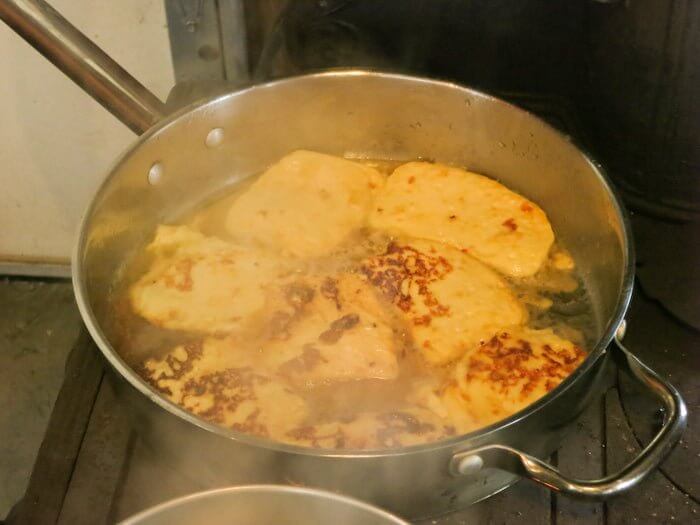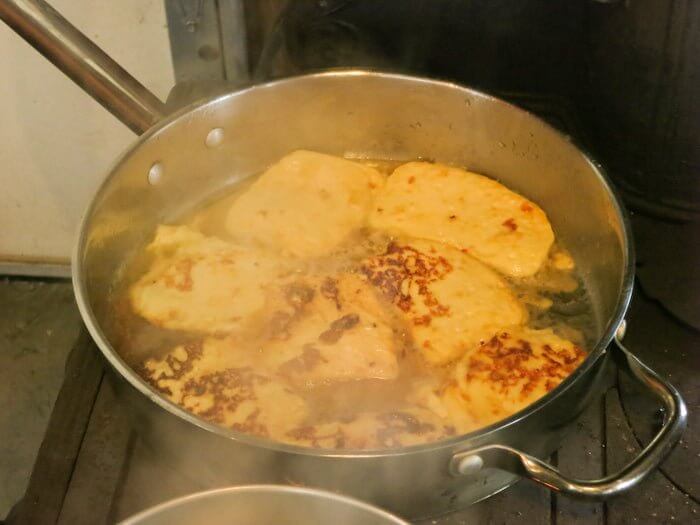
Schiz Cheese Making Recipe
-
Aging Time
None
-
Skill Level
Beginner
-
Author
Jim Wallace

Schiz Cheese Making Recipe Info
Inspiration Behind Schiz Cheese
History of Schiz Cheese
About Schiz Cheese
Making and Enjoying Schiz
Ingredients
Total price for selected items: Total price:
Instructions
-

Heat Milk
Begin by heating the milk to 96F (35C). You do this by placing the pot of milk in another larger pot or sink of very warm water. If you do this in a pot on the stove make sure you heat the milk slowly and stir it well as it heats.
No culture will be added. This will allow all of the lactose in the milk to remain in the cheese, which gives the cheese a very sweet flavor and that wonderful caramelization when the cheese is fried. It will also mean that the cheese needs to be eaten fresh to keep any non-dairy bacteria from producing bad flavors and smells.
If using pasteurized cold stored milk or having problems with forming a firm curd add 1/4 tsp calcium chloride to the milk while heating.
-

Coagulate with Rennet
Then add 1/4 tsp (1.25ml) single strength rennet or ~ 1/4 tablet. Stir for one minute with an up and down motion with the spoon or ladle, then stop the milk moving with a slight back stir.
The milk now needs to set (still) for 30 minutes while the rennet works and coagulates the milk into a firm curd. You will notice the milk beginning to thicken at about 5-10 minutes, as in the photo to the right.
The thermal mass of this milk should keep it warm during this period. It is OK if the temperature drops a few degrees during this time.
-

Cut Curd
Next, cut the coagulated curd in a vertical direction with your knife both ways across.
Allow this to set for 2-3 minutes while the whey begins to show in the cuts.
Then, cut horizontally with a ladle or spoon, resulting in the final curds being the size of beans or corn.
-


Cook Curd
Now, it is time to begin drying out the curds. This will be done by returning the heat to 96F (35C). The total cooking time will be 20-30 minutes. The longer it is cooked, the drier the final cheese will be.
The final curds should be cooked well through and should be examined to make sure that enough moisture has been removed. A broken curd should be firm throughout and the curds should have a moderate resistance when pressed between the fingers.
When this point is reached, the curds can be allowed to settle under the whey
-







Forming & Pressing
The whey should now be removed with a ladle to about an inch above the surface of the curds. Leaving a bit of whey for the transfer will help the cheese consolidate.
Now, simply transfer the curds to the basket mold and allow the whey to drain.
A small amount of weight (1-2 lbs) can help consolidate the curd and produce a slightly drier curd, but this is optional. Here, I have used just a bit of hand pressure to consolidate the cheese. Plus, the weight of the cheese during the drainage seems to give me the texture I want.
Turn the curds as they drain and firm up. Doing this several times during the draining will keep the moisture even. The cheese is now ready to use and due to its high lactose (milk sugar not fermented) it will go "off" in just a few days.
The draining cheese should be placed in the refrigerator as soon as the whey drainage slows, but with a bowl underneath to collect the small amount of whey that continues to drain.
-



Cooking Schiz
To cook, start with half a block of cheese made from 2.5 gallons of milk the night before.
Slice it up to size for the pan. Then add a bit of butter into the pan to melt along with a pinch or two of salt.
Add sliced cheese into the pan. Liquid whey will drain from the cheese while cooking.
The cheese softens but does not melt. It will have a beautiful caramelization.
Pour in a little cream, just in case there isn't enough butterfat. This is a great combination with the cream sauce to go with polenta or even over some wide cut pasta like Pappardelle.
-





Adding Polenta
Polenta is a coarsely ground corn, typically used in this northern region of Italy as the major carbohydrate and can be anything from a base of simply ground corn and water to richer dishes with the addition of cheese, peppers, truffle oil, etc. It can be served directly from the pan or cooled and grilled for a greater depth of flavor.
A bit further south along the Po River Valley, the dominant starch is rice and further south it becomes wheat-based as in pasta. This fried cheese can be served with any of these but here in the north it will be served with polenta.
With the wood fire throwing out a good amount of heat, one of the lids is taken off the wood stove and the heavy copper polenta pan is placed right over the open fire. Don't worry, Italians say that all good polenta needs to form a good crust, but just don't burn it.
Our basic recipe is:
- 3 cups of water for every 1 cup of polenta (coarse grind is our choice)
- Add about 2 tsp salt for every 3 cups of water
- Get the water boiling good then add the polenta slowly while whisking to keep it from clumping
- Let the fire die back a bit (or turn the burner down) to a low boil and keep stirring for 25-30 minutes
- If it thickens up a bit you can add more water
Once the polenta is finished, it can now be either served up or poured into a pan to cool, where it can be cut and reheated or grilled before serving.
Our fried Schiz in cream with Polenta is now ready and it is time for lunch.
Cheese Making Supplies
Related Products
You May Also Like




































